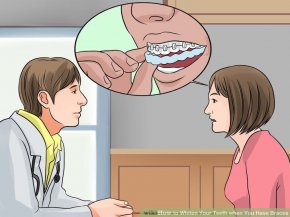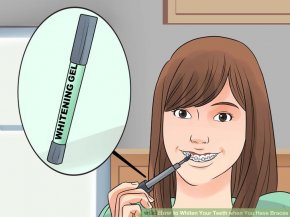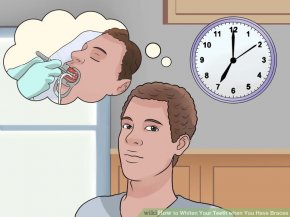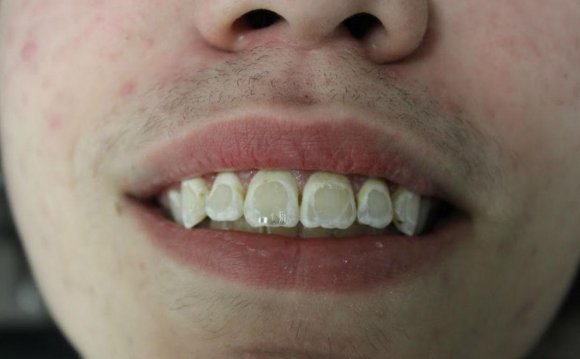
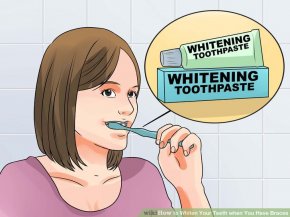 Consider using whitening toothpastes. Look for brands that are American Dental Association (ADA) approved, because they contain fluoride: a mineral essential for dental health.
Consider using whitening toothpastes. Look for brands that are American Dental Association (ADA) approved, because they contain fluoride: a mineral essential for dental health.
- Whitening toothpastes contain special abrasives such as baking soda and peroxide to remove surface stains from teeth.
- However, these products will only remove surface stains. They will not change the color of your enamel entirely.
- Whitening toothpastes won't cause any problems for people with braces. The abrasives in the toothpaste won't cause any breakdown of cement or wear on your wires.
Brush your teeth carefully. Start by putting a pea-sized amount of whitening toothpaste on your brush. You don't need a huge amount of toothpaste to clean your teeth!
- Dentists recommend a round-ended toothbrush with soft bristles.
- Electric or sonic toothbrushes are preferable since they do a more thorough job; however, you may still need an interdental toothbrush to clean around your brackets.
- Place your toothbrush at a 45 degree angle to the gums.
- Gently brush in side to side strokes.
- Be sure to brush the front, back, biting surfaces of all of your teeth.
- Brushing your teeth should take at least two to three minutes.
- If you have any stubborn areas around your brackets and wires, you can use a cone-shaped (interdental) toothbrush. Most orthodontists and dentists will be able to supply you with these. These brushes are small and are designed to fit under the wires of braces.
- If your braces are shiny and all parts of the brackets are visible, you have done a good job.
- Brush your teeth this way after each meal.
This can be difficult when you have braces.
- Thread the floss under the wires of your braces.
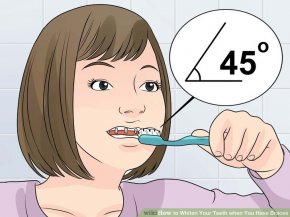 Then floss as you normally would, making sure you get deep into the spaces between your teeth.
Then floss as you normally would, making sure you get deep into the spaces between your teeth. - It may take some time for you to get used to flossing with braces, but it's important that you continue to take this step.
- Keeping your teeth flossed is essential for having white teeth. Food and other debris caught between your teeth can cause decay and discoloration. In addition, you can develop gingivitis or other gum disease.
- If you have any difficulty getting the floss underneath your wires, you can use a floss threader. These are very inexpensive and are available at most pharmacies.
Rinse your mouth with water after eating. When you eat food, your mouth temporarily becomes acidic. This softens the enamel on your teeth, so if you brush immediately after eating you can damage the enamel. Wait at least 30 minutes after eating to brush your teeth and, in the meantime, rinse with water to prevent stains.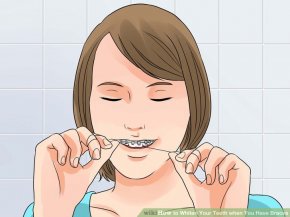 Whitening toothpastes can remove stains, but they won't prevent them.
Whitening toothpastes can remove stains, but they won't prevent them.
- Coffee, tea, wine, and even blueberries can stain your teeth.
- Smoking can also yellow your teeth.
- Rather than avoiding healthy foods that might stain, you should rinse your mouth after eating.
- Floss regularly to remove particles of foods from between your teeth and under your braces.
Method 2
Using At-Home Whitening Treatments
- Consider using at-home whitening trays. These are generally prepared for you by your dentist. This is the only at-home whitening treatment that carries the seal of approval from the ADA.
- Schedule an appointment with your dentist or orthodontist to discuss this procedure.
- Your dentist will fit you with a custom-made tray that fits over your teeth and braces.
- You will put a 10% carbamide peroxide solution in these trays.
- Some treatment plans recommend using the trays twice a day while others recommend overnight use for one to two weeks.
- The average cost of this treatment is 0.00. This is a very effective and more affordable option than in-office whitening. Plus, it is done from the comfort of your own home, and you should not experience any sensitivity or other major side effects.
- Simply slide the tray with the bleaching solution in it over your teeth and let it sit.
- If you have Invisalign braces, this option is very easy. Just remove your Invisalign tray while you use the whitening tray.
- Try paint-on whitening gels. These products are available without a prescription at most pharmacies.
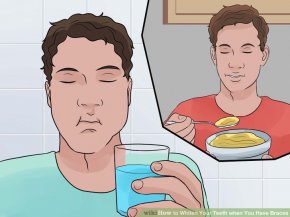 These paint-on gels don't have the seal of approval from the ADA as effective teeth whitening products.
These paint-on gels don't have the seal of approval from the ADA as effective teeth whitening products.
- These products require you to paint a bleaching gel onto your teeth that then hardens within 30 minutes.
- To remove the gel, you simply brush your teeth.
- These can be hard to apply around brackets and wires if you have braces.
- These gels contain lower concentrations of hydrogen peroxide than in-office or dentist prepared options.
- Paint-on bleaching gels don't have the same effectiveness as tray treatments. Results may vary from person to person.
- Understand that at-home bleaching treatments may have some minor side effects. These range from gum irritation to increased tooth sensitivity.
- Bleaching agents in tooth whitening kits are chemicals that can irritate the soft tissues in your mouth. If the concentration percentage of carbamide or hydrogen peroxide is under 15%, then any discomfort should be minimal. If you are using whitening trays, irritation usually only occurs if your trays do not fit properly or you overfill the trays.
- You may experience sores or swelling in your gums as a result of these treatments.
- Another side effect of some whitening treatments is increased sensitivity. If you are using a whitening treatment that is under 10% carbamide or hydrogen peroxide and you experience sensitivity, then you should not proceed with treatment.
- The increased sensitivity can be bothersome to patients with braces, especially around the time your braces are tightened.
- Avoid using these products several days before and after your braces are tightened.
- If you find the side effects hard to deal with, call your dentist or orthodontist for some solutions. They may be able to provide you with a new tray or ways to keep the whitening products off of your gums.
